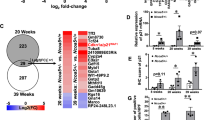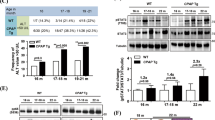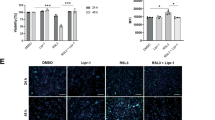Abstract
Hepatocellular carcinoma (HCC) is the third leading cause of cancer-related deaths worldwide, and is on the rise in the United States. Previous studies showed that the matricellular protein CCN1 (CYR61) is induced during hepatic injuries and functions to restrict and resolve liver fibrosis. Here, we show that CCN1 suppresses hepatocarcinogenesis by inhibiting carcinogen-induced compensatory hepatocyte proliferation, thus limiting the expansion of damaged and potentially oncogenic hepatocytes. Consistent with tumor suppression, CCN1 expression is downregulated in human HCC. Ccn1ΔHep mice with hepatocyte-specific deletion of Ccn1 suffer increased HCC tumor multiplicity induced by the hepatocarcinogen diethylnitrosamine (DEN). Knockin mice (Ccn1dm/dm) that express an integrin α6β1-binding defective CCN1 phenocopied Ccn1ΔHep mice, indicating that CCN1 acts through its α6β1 binding sites in this context. CCN1 effectively inhibits epidermal growth factor receptor (EGFR)-dependent hepatocyte proliferation through integrin α6-mediated accumulation of reactive oxygen species (ROS), thereby triggering p53 activation and cell cycle block. Consequently, Ccn1dm/dm mice exhibit diminished p53 activation and elevated compensatory hepatocyte proliferation, resulting in increased HCC. Furthermore, we show that a single dose of the EGFR inhibitor erlotinib delivered prior to DEN-induced injury was sufficient to block compensatory proliferation and annihilate development of HCC nodules observed 8 months later, suggesting potential chemoprevention by targeting CCN1-inhibitable EGFR-dependent hepatocyte proliferation. Together, these results show that CCN1 is an injury response protein that functions not only to restrict fibrosis in the liver, but also to suppress hepatocarcinogenesis by inhibiting EGFR-dependent hepatocyte compensatory proliferation.
This is a preview of subscription content, access via your institution
Access options
Subscribe to this journal
Receive 50 print issues and online access
$259.00 per year
only $5.18 per issue
Buy this article
- Purchase on Springer Link
- Instant access to full article PDF
Prices may be subject to local taxes which are calculated during checkout







Similar content being viewed by others
References
Yang JD, Roberts LR . Hepatocellular carcinoma: A global view. Nat Rev Gastroenterol Hepatol 2010; 7: 448–458.
Centers for Disease Control and Prevention (CDC). Hepatocellular carcinoma—United States, 2001-2006. MMWR Morb Mortal Wkly Rep 2010; 59: 517–520.
Guichard C, Amaddeo G, Imbeaud S, Ladeiro Y, Pelletier L, Maad IB et al. Integrated analysis of somatic mutations and focal copy-number changes identifies key genes and pathways in hepatocellular carcinoma. Nat Genet 2012; 44: 694–698.
Baffy G, Brunt EM, Caldwell SH . Hepatocellular carcinoma in non-alcoholic fatty liver disease: an emerging menace. J Hepatol 2012; 56: 1384–1391.
Jun JI, Lau LF . Taking aim at the extracellular matrix: CCN proteins as emerging therapeutic targets. Nat Rev Drug Discov 2011; 10: 945–963.
Mo FE, Muntean AG, Chen CC, Stolz DB, Watkins SC, Lau LF . CYR61 (CCN1) is essential for placental development and vascular integrity. Mol Cell Biol 2002; 22: 8709–8720.
Mo F-E, Lau LF . The matricellular protein CCN1 is essential for cardiac development. Circ Res 2006; 99: 961–969.
Jun JI, Lau LF . The matricellular protein CCN1 induces fibroblast senescence and restricts fibrosis in cutaneous wound healing. Nat Cell Biol 2010; 12: 676–685.
Choi JS, Kim KH, Lau LF . The matricellular protein CCN1 promotes mucosal healing in murine colitis through IL-6. Mucosal Immunol e-pub ahead of print 25 March 2015.
Kim KH, Chen CC, Monzon RI, Lau LF . The matricellular protein CCN1 promotes regression of liver fibrosis through induction of cellular senescence in hepatic myofibroblasts. Mol Cell Biol 2013; 33: 2078–2090.
Kim KH, Chen C-C, Alpini G, Lau LF . CCN1 induces ductular reaction through integrin αvβ5-mediated NFκB activation. J Clin Invest 2015; 125: 1886–1900.
Lai D, Ho KC, Hao Y, Yang X . Taxol resistance in breast cancer cells is mediated by the Hippo pathway component TAZ and its downstream transcriptional targets Cyr61 and CTGF. Cancer Res 2011; 71: 2728–2738.
Tsai MS, Bogart DF, Castaneda JM, Li P, Lupu R . Cyr61 promotes breast tumorigenesis and cancer progression. Oncogene 2002; 21: 8178–8185.
Gery S, Xie D, Yin D, Gabra H, Miller C, Wang H et al. Ovarian carcinomas: CCN genes are aberrantly expressed and CCN1 promotes proliferation of these cells. Clin Cancer Res 2005; 11: 7243–7254.
Haque I, Mehta S, Majumder M, Dhar K, De A, McGregor D et al. Cyr61/CCN1 signaling is critical for epithelial-mesenchymal transition and stemness and promotes pancreatic carcinogenesis. Mol Cancer 2011; 10: 8.
Xie D, Yin D, Tong X, O'Kelly J, Mori A, Miller C et al. Cyr61 is overexpressed in gliomas and involved in integrin-linked kinase-mediated Akt and beta-catenin-TCF/Lef signaling pathways. Cancer Res 2004; 64: 1987–1996.
Tong X, Xie D, O'Kelly J, Miller CW, Muller-Tidow C, Koeffler HP . Cyr61, a member of CCN family, is a tumor suppressor in non-small cell lung cancer. J Biol Chem 2001; 276: 47709–47714.
Chien W, Kumagai T, Miller CW, Desmond JC, Frank JM, Said JW et al. Cyr61 suppresses growth of human endometrial cancer cells. J Biol Chem 2004; 279: 53087–53096.
Babic AM, Kireeva ML, Kolesnikova TV, Lau LF . CYR61, product of a growth factor-inducible immediate-early gene, promotes angiogenesis and tumor growth. Proc Natl Acad Sci USA 1998; 95: 6355–6360.
Todorovic V, Chen C-C, Hay N, Lau LF . The matrix protein CCN1 (CYR61) induces apoptosis in fibroblasts. J Cell Biol 2005; 171: 559–568.
Chen C-C, Young JL, Monzon RI, Chen N, Todorovic V, Lau LF . Cytotoxicity of TNFα is regulated by Integrin-Mediated Matrix Signaling. EMBO J 2007; 26: 1257–1267.
Feng P, Wang B, Ren EC . Cyr61/CCN1 is a tumor suppressor in human hepatocellular carcinoma and involved in DNA damage response. Int J Biochem Cell Biol 2008; 40: 98–109.
Li ZQ, Ding W, Sun SJ, Li J, Pan J, Zhao C et al. Cyr61/CCN1 is regulated by Wnt/beta-catenin signaling and plays an important role in the progression of hepatocellular carcinoma. PLoS ONE 2012; 7: e35754.
Bakiri L, Wagner EF . Mouse models for liver cancer. Mol Oncol 2013; 7: 206–223.
Lee JS, Chu IS, Mikaelyan A, Calvisi DF, Heo J, Reddy JK et al. Application of comparative functional genomics to identify best-fit mouse models to study human cancer. Nat Genet 2004; 36: 1306–1311.
El-Serag HB . Hepatocellular carcinoma. N Engl J Med 2011; 365: 1118–1127.
Hiotis SP, Rahbari NN, Villanueva GA, Klegar E, Luan W, Wang Q et al. Hepatitis B vs hepatitis C infection on viral hepatitis-associated hepatocellular carcinoma. BMC Gastroenterol 2012; 12: 64.
Maeda S, Kamata H, Luo JL, Leffert H, Karin M . IKKbeta couples hepatocyte death to cytokine-driven compensatory proliferation that promotes chemical hepatocarcinogenesis. Cell 2005; 121: 977–990.
Chen X, Cheung ST, So S, Fan ST, Barry C, Higgins J et al. Gene expression patterns in human liver cancers. Mol Biol Cell 2002; 13: 1929–1939.
Wurmbach E, Chen YB, Khitrov G, Zhang W, Roayaie S, Schwartz M et al. Genome-wide molecular profiles of HCV-induced dysplasia and hepatocellular carcinoma. Hepatology 2007; 45: 938–947.
Mas VR, Maluf DG, Archer KJ, Yanek K, Kong X, Kulik L et al. Genes involved in viral carcinogenesis and tumor initiation in hepatitis C virus-induced hepatocellular carcinoma. Mol Med 2009; 15: 85–94.
Roessler S, Jia HL, Budhu A, Forgues M, Ye QH, Lee JS et al. A unique metastasis gene signature enables prediction of tumor relapse in early-stage hepatocellular carcinoma patients. Cancer Res 2010; 70: 10202–10212.
Kang JS, Wanibuchi H, Morimura K, Gonzalez FJ, Fukushima S . Role of CYP2E1 in diethylnitrosamine-induced hepatocarcinogenesis in vivo. Cancer Res 2007; 67: 11141–11146.
Verna L, Whysner J, Williams GM . N-nitrosodiethylamine mechanistic data and risk assessment: bioactivation, DNA-adduct formation, mutagenicity, and tumor initiation. Pharmacol Ther 1996; 71: 57–81.
Kuraishy A, Karin M, Grivennikov SI . Tumor promotion via injury- and death-induced inflammation. Immunity 2011; 35: 467–477.
Juric V, Chen CC, Lau LF . Fas-mediated apoptosis is regulated by the extracellular matrix protein CCN1 (CYR61) in vitro and in vivo. Mol Cell Biol 2009; 29: 3266–3279.
Chen N, Leu S-J, Todorovic V, Lam SCT, Lau LF . Identification of a novel integrin αvβ3 binding site in CCN1 (CYR61) critical for pro-angiogenic activities in vascular endothelial cells. J Biol Chem 2004; 279: 44166–44176.
Giono LE, Manfredi JJ . The p53 tumor suppressor participates in multiple cell cycle checkpoints. J Cell Physiol 2006; 209: 13–20.
Stepniak E, Ricci R, Eferl R, Sumara G, Sumara I, Rath M et al. c-Jun/AP-1 controls liver regeneration by repressing p53/p21 and p38 MAPK activity. Genes Dev 2006; 20: 2306–2314.
Dumaz N, Meek DW . Serine15 phosphorylation stimulates p53 transactivation but does not directly influence interaction with HDM2. EMBO J 1999; 18: 7002–7010.
She QB, Chen N, Dong Z . ERKs and p38 kinase phosphorylate p53 protein at serine 15 in response to UV radiation. J Biol Chem 2000; 275: 20444–20449.
Llovet JM, Burroughs A, Bruix J . Hepatocellular carcinoma. Lancet 2003; 362: 1907–1917.
Sun B, Karin M . Inflammation and liver tumorigenesis. Front Med 2013; 7: 242–254.
Liebermann DA, Hoffman B, Vesely D . p53 induced growth arrest versus apoptosis and its modulation by survival cytokines. Cell Cycle 2007; 6: 166–170.
Teoh N, Pyakurel P, Dan YY, Swisshelm K, Hou J, Mitchell C et al. Induction of p53 renders ATM-deficient mice refractory to hepatocarcinogenesis. Gastroenterology 2010; 138: 1155–1165.
Sakurai T, Kudo M, Umemura A, He G, Elsharkawy AM, Seki E et al. p38alpha inhibits liver fibrogenesis and consequent hepatocarcinogenesis by curtailing accumulation of reactive oxygen species. Cancer Res 2013; 73: 215–224.
Mellert H, Espinosa JM . Tumor suppression by p53: is apoptosis important or not? Cell Rep 2013; 3: 1335–1336.
Kardeh S, Ashkani-Esfahani S, Alizadeh AM . Paradoxical action of reactive oxygen species in creation and therapy of cancer. Eur J Pharmacol 2014; 735: 150–168.
Juric V, Chen CC, Lau LF . Fas-mediated apoptosis is regulated by the extracellular matrix protein CCN1 (CYR61) in vitro and in vivo. Mol Cell Biol 2009; 29: 3266–3279.
Yan HX, Wu HP, Zhang HL, Ashton C, Tong C, Wu J et al. DNA damage-induced sustained p53 activation contributes to inflammation-associated hepatocarcinogenesis in rats. Oncogene 2013; 32: 4565–4571.
Ciardiello F, Tortora G . EGFR antagonists in cancer treatment. N Engl J Med 2008; 358: 1160–1174.
Thomas MB, Chadha R, Glover K, Wang X, Morris J, Brown T et al. Phase 2 study of erlotinib in patients with unresectable hepatocellular carcinoma. Cancer 2007; 110: 1059–1067.
Schiffer E, Housset C, Cacheux W, Wendum D, Desbois-Mouthon C, Rey C et al. Gefitinib, an EGFR inhibitor, prevents hepatocellular carcinoma development in the rat liver with cirrhosis. Hepatology 2005; 41: 307–314.
Fuchs BC, Hoshida Y, Fujii T, Wei L, Yamada S, Lauwers GY et al. Epidermal growth factor receptor inhibition attenuates liver fibrosis and development of hepatocellular carcinoma. Hepatology 2014; 59: 1577–1590.
Smith NF, Baker SD, Gonzalez FJ, Harris JW, Figg WD, Sparreboom A . Modulation of erlotinib pharmacokinetics in mice by a novel cytochrome P450 3A4 inhibitor, BAS 100. Br J Cancer 2008; 98: 1630–1632.
Li WC, Ralphs KL, Tosh Ds . Isolation and culture of adult mouse hepatocytes. Methods Mol Biol 2010; 633: 185–196.
Acknowledgements
We thank Seungwon Shin and Guoqiang Yan for technical assistance. This work was supported by a grant from the NIH (R01GM78492) to LFL.
Author information
Authors and Affiliations
Corresponding author
Ethics declarations
Competing interests
The authors declare no conflict of interest.
Additional information
Supplementary Information accompanies this paper on the Oncogene website
Rights and permissions
About this article
Cite this article
Chen, CC., Kim, KH. & Lau, L. The matricellular protein CCN1 suppresses hepatocarcinogenesis by inhibiting compensatory proliferation. Oncogene 35, 1314–1323 (2016). https://doi.org/10.1038/onc.2015.190
Received:
Revised:
Accepted:
Published:
Issue Date:
DOI: https://doi.org/10.1038/onc.2015.190
This article is cited by
-
Decrease of Cellular Communication Network Factor 1 (CCN1) Attenuates PTZ-Kindled Epilepsy in Mice
Cellular and Molecular Neurobiology (2023)
-
Accumulation of cholesterol, triglycerides and ceramides in hepatocellular carcinomas of diethylnitrosamine injected mice
Lipids in Health and Disease (2021)
-
The CCN2/CTGF interactome: an approach to understanding the versatility of CCN2/CTGF molecular activities
Journal of Cell Communication and Signaling (2021)
-
Circ-GLI1 promotes metastasis in melanoma through interacting with p70S6K2 to activate Hedgehog/GLI1 and Wnt/β-catenin pathways and upregulate Cyr61
Cell Death & Disease (2020)
-
ATF3 inhibits the tumorigenesis and progression of hepatocellular carcinoma cells via upregulation of CYR61 expression
Journal of Experimental & Clinical Cancer Research (2018)



